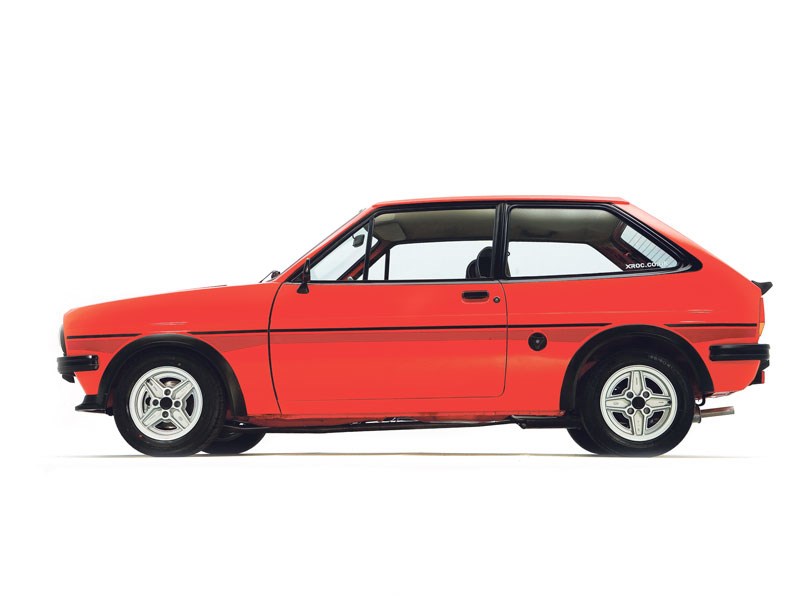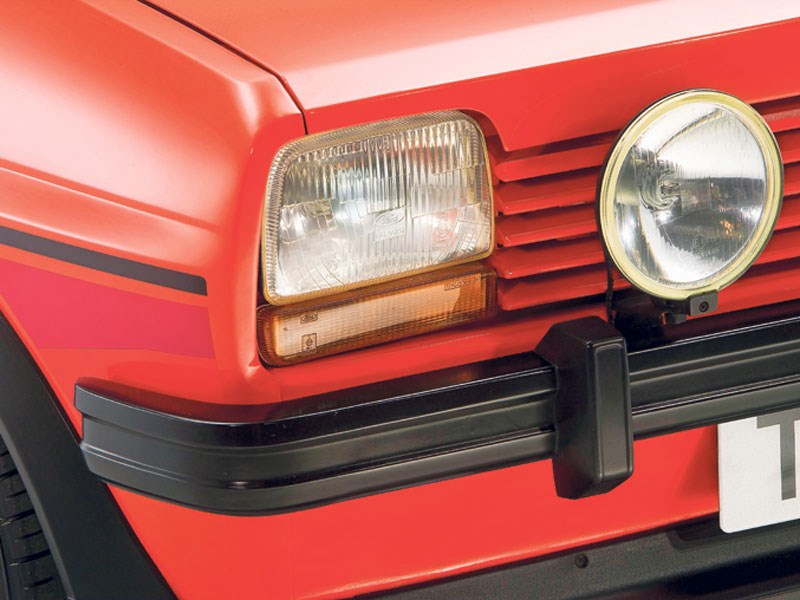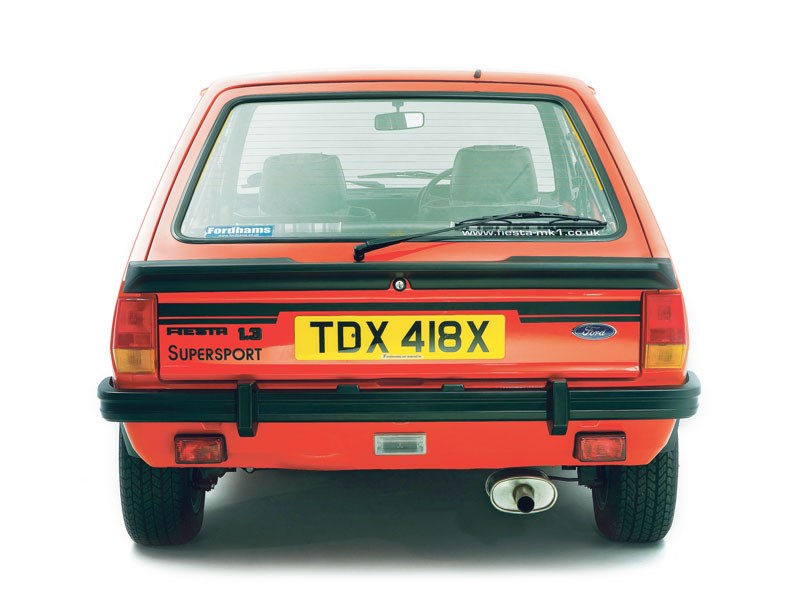Ford was well aware that the market for small, cheap hatchbacks was growing rapidly and in 1976 it announced the arrival of the front-wheel drive Fiesta. Simplicity was the watchword with a lightweight steel monocoque body and a range of peppy, economical engines. A huge number rolled off the German, Spanish, and Dagenham production lines.
It’s this simple approach that makes the Fiesta so appealing today and it is easy to see why so many survive, albeit in widely varying condition. The fact that there is a trim level and engine option to suit everyone is a bonus too – and if it was sportiness you wanted there was always the lively XR2. There were some impressive special editions as well, the two-tone ‘Sandpiper’ being particularly lovely.
XR2s aside, the Fiesta isn’t about performance or pin-sharp handling. But what it does do extremely well is provide roomy and practical transport and an impressively tidy driving experience. Unless you rarely venture out of town, the smallest engines do feel a little underpowered, but the 1.3-litre unit is more than capable of pushing the Fiesta along in modern traffic. Leave the urban sprawl and you’ll notice that there’s a degree of entertainment to be had too.
The steering is light and direct and the combination of a composed ride and secure handling means tackling a twisty road is a pleasure. The comfortable cabin is a real plus too, and while it might be simple, everything is within easy reach and the driving position is spot-on.
Run-of-the-mill model prices have changed little in recent times. Those at the very bottom of the scale show little sign of increasing and with the cost of re-commissioning likely to exceed the car’s value, these are probably best considered as parts donors only. Avoid any cars that have been modified or tampered with by DIYers and boy racers. The condition can vary widely and there are a few optimistic vendors out there hoping to cash-in on the Fiesta’s classic status, but you should be wary of paying over the odds. The best advice is to spend as much as you can afford on a cherished, rust-free example benefitting from everything the Fiesta has to offer without the need for costly restoration.
VITAL STATISTICS
Ford Fiesta MKI
Engine 1598cc/4-cyl/OHV/Bosch injection
Power (bhp@rpm) 84bhp@5500rpm
Torque (lb ft@rpm) 91lb ft@2800rpm
Top speed 106mph
0-60mph 9.4sec
Consumption 32mpg
WHAT TO LOOK FOR
BODYWORK & CHASSIS
Rust can break out just about anywhere on the Fiesta and you’ll need to pay close attention to the tops of the front wings, the wheel arches, sills, and front valance. All of the main panels are susceptible to rot, so having a magnet handy will help you avoid being landed with someone else’s previous bodgery. Few examples will have escaped the need for replacement front suspension turrets, so be extra vigilant here and around the inner wings. Replacement panels are getting scarce so a hunt for decent second-hand parts will be needed.
A thorough check of the underside is advisable as boot floors and inner sills can rot through. Lift up carpets and mats to ensure water leaks haven’t accelerated the process. Take a good look around the front and rear suspension mountings as well as corrosion here has caused many a Fiesta to fall foul of the MoT tester.
It is under the bonnet where the simplicity of the Fiesta really pays off, and while there are some checks to be done, you’ll be hard pressed to find a more DIY-friendly car. The Kent and Valencia engines ranged in size from the 957cc unit up to the punchy 1.6-litre mill fitted to the XR2. General wear and tear is the main thing to look for, including noisy valvegear, rattling timing chains, and exhaust smoke caused by worn valve guides. Furred-up cooling systems eventually lead to headgasket failure so look for signs of recent overheating, and check for niggling oil leaks, though these are easy to cure. A blocked crankcase breather system can suck fumes in the cabin, so its worth checking here first before assuming it is something more serious.
ENGINE
Carburettor engines were fitted with Solex units when new, but these were notorious for starting problems and many owners have replaced them with Webers. So a non-standard carburettor isn’t necessarily a warning to look for other modifications! Poor starting may also be cured relatively easily by a swap from the original specification.
Bosch mechanical fuel injection was a feature of the six-cylinder 220SE and 300SE/SEL models. It’s pretty reliable but is not really a DIY job when it goes wrong. Getting it fixed can often prove very expensive. Some recommend retarding the ignition timing on injected engines as a safety measure now that there’s no more high-octane leaded petrol.
Bosch mechanical fuel injection was a feature of the six-cylinder 220SE and 300SE/SEL models. It’s pretty reliable but is not really a DIY job when it goes wrong. Getting it fixed can often prove very expensive. Some recommend retarding the ignition timing on injected engines as a safety measure now that there’s no more high-octane leaded petrol.
RUNNING GEAR
Four-speed manual gearboxes were very robust, so it is really just a case of looking out for tired synchromesh and excessive noise caused by worn pinion shaft bearings. An obstructive gearshift is often due to worn gear linkages or a clutch in need of replacement, but both are cheap to fix. Worn differential bearings will cause a noticeable whine on the test drive, but they can soldier on for many miles without needing replacement if you can put up with the noise.
BRAKES
The suspension set-up is simple and uses MacPherson struts at the front. Sagging springs and dampers and worn bushes are likely ailments, but bringing them up to scratch isn’t costly. Rear suspension arm rubbers wear, but it isn’t a difficult fix. The disc/drum brakes aren’t likely to be stretched by the performance, so regular maintenance should have kept things working well. Rear brakes can seize on lightly-used cars, an overhaul is straightforward and cheap. Check, too, for play in the rack-and-pinion steering and noisy wheel bearings. Lastly, the Pepperpot alloys fitted to XR2 models are desirable on all models. But the XR2’s standard-issue plastic wheeltrims are all but extinct, so if you find them, cherish them!
INTERIOR
Interior trim is getting hard to source now, so don’t underestimate the cost needed to bring a tatty cabin up to scratch. Lower trim levels were incredibly basic on the early models, even down to plastic seats, and are best avoided. A smattering
of comfort features enhanced GL models, but
it’s the Ghia that provides the most comfortable cabin. Velour seats, four-spoke steering wheel,
rev counter, and faux-woodgrain trim were all standard. The centre consoles fitted to these higher-spec models can vibrate greatly, upsetting modern CD players, so a Ford-branded cassette deck is a bonus, or re-install original equipment when you find it for sale. Specialist re-trimmers can tackle worn seats and carpets, but it’s easier and cheaper to choose a car with a complete and original interior.
OUR VERDICT
Whether it is a first classic that you’re after, or a simple runaround with a bit of character the Fiesta will almost certainly fit the bill. There are plenty to choose from and prices remain accessible for those on a budget. A bit of care is needed when buying – there are plenty of bangers in the classifieds that have barely yards left in them before the crusher beckons – but be prepared to look at plenty of cars and this popular hatch will prove a reliable companion.
Ford was well aware that the market for small, cheap hatchbacks was growing rapidly and in 1976 it announced the arrival of the front-wheel drive Fiesta. Simplicity was the watchword with a lightweight steel monocoque body and a range of peppy, economical engines. A huge number rolled off the German, Spanish, and Dagenham production lines.
It’s this simple approach that makes the Fiesta so appealing today and it is easy to see why so many survive, albeit in widely varying condition. The fact that there is a trim level and engine option to suit everyone is a bonus too – and if it was sportiness you wanted there was always the lively XR2. There were some impressive special editions as well, the two-tone ‘Sandpiper’ being particularly lovely.



